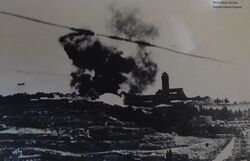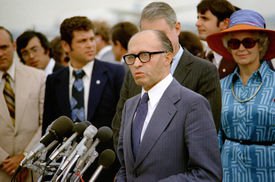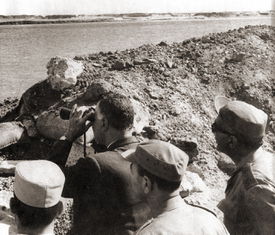Difference between revisions of "How Did the 1967 War Shape the Middle East"
m (Admin moved page How Did the 1967 War Shape the Middle East? to How Did the 1967 War Shape the Middle East) |
|
(No difference)
| |
Latest revision as of 16:28, 14 September 2021
Six days in June 1967 forever altered the landscape of the Middle East. Many of the modern conflicts in the region find their roots in the dramatic changes of that period. A multitude of consequences continue to shape interactions between Israelis, Palestinians, Arabs and the rest of the world. However, major political, economic, demographic and social changes took place immediately after the conflict. Specifically, political legitimacy, the occupied territories and Middle Eastern identity experienced vast transformations. Those transformations, in addition to United States involvement, would significantly impact foreign affairs for years to come.
Background
In early 1967, Syria and Israel had been fighting about water rights (specifically the Jordan River). As a show of pan-Arabism (a secular Arab identity), Egyptian President Gamal Nasser blocked Israeli from accessing the Red Sea for shipping. Israelis viewed this as an act of war since the entrance to the Red Sea was considered to be an international waterway. The 1967 (also known as Six-Day War) began on June 5, 1967 as Israel pre-emptively attacked Egypt’s air force. Over the next few days it destroyed 90% of the Egyptian air force while crippling Syria’s air force as well. Israeli ground troops also forced Jordanian troops out of Jerusalem. On June 7, a ceasefire was declared.[1]
Political Changes
Politics and political legitimacy following the 1967 War resulted in completely different outcomes for Israelis and Arabs in the region. Israel arguably achieved some level of political legitimacy through massive land acquisition and bargaining power over neighboring Arab states. Israel gained all of Jerusalem, the West Bank, the Sinai Peninsula, the Gaza Strip and the Golan Heights in only six days.[2] The Israeli government announced a bargaining deal with Arabs involving the exchange of land for peace. To address the issue of land ownership immediately following the conflict, the United Nations Security Council put forth Resolution 242 which specified the inadmissibility of gaining territory through war.[3] However, Israel used the occupied territories as bargaining chips. For example, Israel negotiated for peace with Egypt in 1978 following of years of conflict that began with the 1973 October War.
While this was a victory for Israel and its land for peace equation, Egypt was given the Sinai Peninsula. But discussion about the Palestinian refugee crisis was not addressed.[4] While the treaty points out Israel’s compliance with Resolution 242, it fails to acknowledge the conditions of the resolution that Israel did not follow, such as settling the refugee problem within the occupied territories. With massive land gains and political and military advantages, Israel found itself in a position to take bolder steps in obtaining and securing land. In a controversial move, Israel named Jerusalem as the country’s everlasting capital as part of an era of new assertiveness that lasted well into the 1980s (with Prime Minister Menachem Begin’s government.[5][6]
Although the 1967 War is sometimes seen as a struggle between Israelis and Palestinians, all neighboring Arab states were greatly affected by the unstable political environment. Jordan lost control of the West Bank and Syria relinquished control of the Golan Heights.[7] The loss of the Sinai Peninsula, the Gaza Strip, and, more importantly, President Nasser’s loss of political credibility were particularly detrimental to Egypt. No longer did Nasser’s dream of pan-Arabism seem possible after such a concerted failure by Arab states to defend Palestinians. It was in the atmosphere of failed pan-Arabism that the Palestinian Liberation Organization (PLO) gained a stronger foothold under their leader, Yasir Arafat. Formed in 1964, the PLO was created around the idea that Palestinians should be self-reliant in their efforts to regain a Palestinian state.[8] This guiding tenet removed not only the expectations for Arab financial and military aid, but had the effect of weakening an already diminished Arab authority.
Economic and Demographic Changes
Numerous economic and demographic programs influenced the expanded occupied territories. Israel initiated several settlement programs which dramatically changed life for Palestinians living in the occupied territories. Low-cost housing for Israelis was subsidized by the Israeli government in an attempt to promote immigration to the newly acquired territories. Religious settlers flocked to the territory of the West Bank as Jerusalem expanded. Problematically, Israel also linked the electrical grid and water table of the West Bank to their system.[9] Thus, Israel created a dependent economy based on buying and selling with the Palestinians. For Palestinians, the increased settlement exacerbated the refugee crisis. Following the war, 300,000 Palestinians fled to Jordan while Syria absorbed 80,000 refugees.[10] Again, the conflict becomes a Middle Eastern one when other Arab nations must absorb large numbers of Palestinian refugees. Neighboring Arab states that lost territories, namely Egypt and Jordan, were economically stunted from the loss of land. Egypt sought subsidies to make up for the loss of revenue and Jordan had to deal with the loss of its most fertile land. Syria also faced lack of security as Damascus was within easy striking distance of Israel and many refugees had fled there.
Changes to Identity
These changes in politics and geography altered not only Israeli and Palestinian identity, but reversed the advances of pan-Arabism. After Nasser’s self-perceived failure, he briefly resigned from the presidency. However, he still clung to the ideals of pan-Arabism when calling for a united Arab response to remove Israeli aggression.[11] He specifically mentioned the United Arab Republic, comprised of Syria and Egypt. It is surprising that he would mention a republic that had only lasted three years before disunity broke it apart. This disenchantment with an Arab state would continue after the war as many Arabs questioned the success of an Arab state following such an overwhelming defeat by a non-Arab and non-Islamic people.

Trouble among Middle Eastern nations only continued after 1967. In 1970, Jordan and Syria began a conflict with each other which resulted in an Arab Summit mediated by Nasser.[12] The major issue on the table was how Arab states needed to live and work together in a world radically changed by the 1967 War. Interestingly, at this time Nasser had been changing his policies of non-alignment and pan-Arabism probably to suit the growing Arab crisis. The self-scrutiny of Nasser and the Arab states created support for Islamization, identity and government based on the religion of Islam rather than pan-Arabism, a more secular identity which strove for a single Arab state.
Although on face, Israel appears to have a strong national unity, its own identity was and continues to be called into question. Increased Israeli settlement in the occupied territories meant the territories were more connected to Israel and faced less isolation from Jewish communities. In addition, a large population of guest-workers had replaced Palestinian workers and questions about their citizenship status had been raised.[13] One of Israel’s key concerns with identity was maintaining a homogenous Israeli society in the midst of a large population of guest workers and Palestinians in the occupied territories.
UN Security Council’s Resolution 242
It is not surprising that in a region so shaped by Western involvement the United Nations and United States would attempt to assert influence once again. Significant to foreign affairs is the United Nations Security Council’s Resolution 242 passed in 1967 as a direct response to the conflict. In its introduction and first major point, the resolution calls for withdrawal of the Israeli troops from occupied territories and respect for territorial boundaries and sovereignty.[14] Obviously, since Israel still occupies the majority of those occupied territories from the 1967 War, this resolution has not been heeded.
Perhaps more importantly is the vagueness of most of the resolution. It argues for territorial and political independence of every state in the region but does not define which states are included nor does it confront the Palestinian crisis in any way. The resolution continues by arguing the need to deal with the refugee problem, but never addresses how this would be accomplished or which parties would mediate. Hidden among the indefinite calls for peace and stability throughout the region is an interesting concern of non-Middle Eastern nations: international waterways. All parties involved realized that without access to the Gaza strip, an independent Palestinian state would be landlocked. Resolution 242 attempted to guarantee international waterway rights. It also called to prevent the acquisition of territory through war, something Israel would rather ignore than follow.[15]
International Involvement
The U.S. would continue to play a large role in the region whether it liked it or not. Historian James Gelvin argues that the Egyptian War of Attrition (1969) against Israel specifically sought to re-engage the U.S. in the affairs of the Middle East.[16] The War of Attrition destroyed the Suez Canal over the period of 1969-1970 and did lead to another response by the U.S. The U.S. Rogers Plan proposed by the Secretary of State ended the War of Attrition in 1970. This meant that all parties accepted the ninety-day ceasefire set forth in the plan. However, tensions between Israel and her neighbors did not relax even after international involvement. In fact, Yasir Arafat stated, “We consider Israel as playing the new role of the East India Company in the Middle East.”[17] This attitude suggests that increased Western involvement only led to suspicion and a renewed sense of imperial involvement.
The Palestinian Liberation Organization (PLO) was largely responsible in shaping Western attitudes about Middle Eastern issues. As Yasir Arafat was the spokesman, his perception of the West as imperialist hardly sat well with the Western international community. The PLO is also an example of how the 1967 War impacted not only Israelis and Palestinians, but also neighboring Arab states. For example, as the PLO moved its base from Lebanon to Syria, it displaced native populations that were troubled by the increased violence. In removing a Palestinian state, the problem of managing a mobile militant representative force continues to be a difficulty.
Conclusion
While many of the political, economic and social issues leave legacies that are easily seen, some of the largest impacts are harder to pinpoint. Perhaps one of the principal effects is a shift in ideology. Before the 1967 War, Arab nations refused to recognize Israel. While this is still a contentious issue, Egypt and Israel signed a peace treaty in 1979, thus recognizing Israel’s existence in exchange for Egyptian control of the Sinai Peninsula.[18] This illustrates how not only the rules were changing but how the game was different. In order to understand changing dynamics among Israel and the world, the massive changes in politics, geography and identity following the 1967 War must be remembered.
References
- ↑ James Gelvin, The Modern Middle East: A History (Oxford University Press, 2008), 273
- ↑ Gelvin, 273
- ↑ U.N. Security Council: Resolution 242, as quoted in Walter Laqueur and Barry Rubin (ed) The Israel-Arab Reader (Penguin, 2001), 116
- ↑ Article II of the Egypt and Israel Peace Treaty, as quoted in Walter Laqueur and Barry Rubin (ed) The Israel-Arab Reader (Penguin, 2001), 228
- ↑ Gelvin, 275
- ↑ Dov Waxman, The Pursuit of Peace and the Crisis of Israeli Identity: Defending/Defining the Nation (Palgrave Macmillan, 2006), 52
- ↑ Gelvin, 273
- ↑ Gelvin, 277
- ↑ Gelvin, 276
- ↑ David Sorenson, An Introduction to the Modern Middle East: History, Religion, Political Economy, Politics (Westview Press, 2013), 351
- ↑ Nasser’s resignation broadcast, as quoted in Walter Laqueur and Barry Rubin (ed) The Israel-Arab Reader (Penguin, 2001), 104
- ↑ Bassil A. Mardelli, Middle East Perspectives: From Lebanon (1968–1988) (iUniverse, 2012), 133
- ↑ Gelvin, 276
- ↑ U.N. Security Council Resolution 242
- ↑ U.N. Security Council Resolution 242
- ↑ Gelvin, 275
- ↑ Yasir Arafat interview 1969, as quoted in Walter Laqueur and Barry Rubin (ed) The Israel-Arab Reader (Penguin, 2001), 139
- ↑ Egypt and Israel: Peace Treaty, as quoted in Walter Laqueur and Barry Rubin (ed) The Israel-Arab Reader (Penguin, 2001), 227-228
Admin, Jgibson and EricLambrecht


